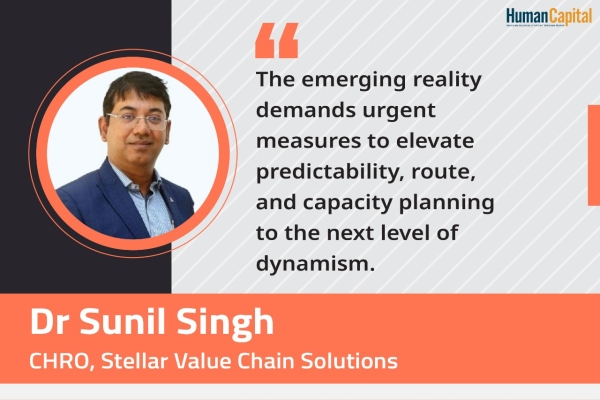Organizations have long realized that annual engagement surveys are passé, and, having a list of scores to various questions is not going to help them navigate the uncertain terrain in a nimble VUCA economy. Engagement surveys are essentially a point-in-time opinion survey, and, human beings are fickle creatures. Their opinions vary with time, and often, have little to do with the internal workings of their mind. All too often, expressed opinion and observed behaviors may be at loggerheads with each other.
Employee Experience is all about perceptions. It is a long-term strategic approach that aligns culture, values, behavior, and processes. Employees view interactions in organizations as a series of experiences, and, form memories that reinforce beliefs or attitudes, and, shape their behavior. Since there are multiple variables in the organization that can impact the behavior:-
1. High Employee engagement is the desired outcome of an ongoing journey of employee experience.
2. Employee experience is an employee-centric way of thinking - organization decisions pivot around employees’ feelings about all aspects of the workplace- physical, emotional and mental.
3. Employee Experience is a Design thinking effort that requires a Cultural shift. Leaders and managers alike need to start thinking about organization processes and interactions with the employee at the center of their attention.
4. Employee experience has many touchpoints, and, HR is not the custodian of Employee Experience. Most touchpoints of employee experience are with line managers, customers, vendors and processes that are beyond the purview of HR. HR can ‘design for an experience, but not control the experience’.
Investing time and effort
Employee Experience management requires a culture where leaders and managers alike put themselves in the center of the paradigm shift. In a sense, all human interactions, whether personal or organizational, require an investment of time and effort in managing expectations and creating alignment, and, most human memories are a result of sentiments attached to an experience. Employee experience is affected by everything happening at work that impacts daily life in and outside the workplace; including the overall physical, emotional, professional, and financial well-being. Engagement is also an outcome of experiences, both in and out of the workplace.
Behavioral Economics begins with the assumption that people will not behave in the most “rational” manner. Certain principles such as the Anchoring principle, the Ostrich effect, and, social proofing can assist organizations in normalizing employee behavior or action through appropriate nudges.
“Behavioural Economics implies that people will not be rational in their behavior. The Anchoring principle, the Ostrich effect, and, social proofing can assist organizations in normalizing employee behavior or action through appropriate nudges.”
The moments of truth
Research has shown that people do not remember everything about an experience, but vividly recall several of its components instead. From an employee experience standpoint, these can be classified as “Moments of truth”, an interaction where an employee forms an impression of the organization. Once these ‘moments’ are identified, Behavioural Economics can transform employee experience by highlighting the engagement touch points, removing cognitive friction experienced by the customer, and, designing behaviourally fluent solutions that make each of the millions of interactions between the company and the employee count.
HR and business leaders come to face the demand and the opportunity to rethink the roles, structure, tools, and, the strategy used by them to design and deliver an integrated employee experience. Journey maps are a starting point to address a variety of issues- meaningful work, the purpose of the organization, employee talent development and growth, rewards and wellness, work environment, fairness and inclusion, and, authenticity among management and leadership.
People managers usually feel that HR business partners are buried in operational tasks, and, do not focus on the growth and development of employees. HR teams are now more focused on employee experience, and, create tools that are more intuitive and user-friendly. The quality of interaction with employees through multiple channels, and programs focussed around capturing employee sentiment. HR has also started building strategic partnerships with line managers and other internal stakeholders in co-creating the experience journey, it has started placing the “employee” in the center of design thinking about their processes or tasks. Just as numerous consumer-facing processes and interactions have been retooled and simplified to provide more satisfying customer experience, HR can begin to shift its approaches as well.
A typical process of employee experience diagnostics follows the process below:
1. Framing the problem statement (hypotheses) accurately and doing proper data extraction and clustering is of great importance in finding the right outcomes, it is a good idea to start with multiple hypotheses and eliminate them as things progress.
2. Sampling tends to invite multiple debates and opinions from various stakeholders, and, it is important to have decent, but quantifiable samples to deal with. Care should be taken during sample selection, and, it needs to be in line with methodology.
3. Eliciting of journey maps can be done through different research techniques, and, selection of technique is dependent on the nature of the problem.
4. Data clustering and extraction makes all the difference in finding the right insight. This step takes more time than data collection itself.
Based on past experience with building an Experience centric People function, the following pointers come to mind:
1. Great Employee Experience comes out of seeing employees as customers.
2. Leaders and managers need to understand what employees mean by ‘Experience’
3. Taskforces on Employee Experience need to comprise of a broad coalition of everyone who touches employees and culture, E.g. Marketing, Branding, Analytics, Real Estate, IT, Design, etc.
4. Organizations that are focused on Employee Experience make Customer Experience and Employee Experience the underlying basis of Cultural Transformation. This requires effort in terms of redesigning workspaces, digital space, service delivery, and, also ways to simplify processes and give employees a sense of autonomy. This requires constant work in innovation and flatter, less hierarchical structures.
5. Employee Experience begins with good diagnostics which can be through multiple channels: observation, interview, chatbots, AI, data mining and more. This can help in mapping employee journeys while listening for feelings and emotion and developing personas. The key to successful mapping is being non‑judgmental and refraining from biasing the data through preconceived filters, or, attempts to modify responses to fit “appropriate insights.”
6. Employee Experience is designed around a series of questions to get at feelings and behaviors that build on predictive data. Asking the right questions is pivotal to eliciting the right answers! Experience is all about perception, so care must be taken that Experiences and feelings of employees are not invalidated. It is important to avoid leading questions. Organizations need to be careful with the usage of the data that they receive. Feedback on what is done with the data that they share is important to ensure that trust is reinforced.
7. Employee Experience requires constant data input – data is not always quantitative, conversations, mannerisms, and, even facial tones are data. Proper analytics capabilities are required to collect and interpret data, as is integrating and connecting a wide variety of data points. Very often, one needs to look beyond pulse surveys and quantitative analysis to obtain real insights.
The idea is to move from a process-driven mindset to one that always begins with the experience for the HR customer—who could be a vendor, candidate, employee, freelancer, or, even alumni. HR leaders are rapidly adopting this experience‑oriented approach, and, applying it to truly rethink how HR work happens. It also helps define HR through the lens of the workforce’s “journey” across processes to shape the desired impression and feeling among the workforce, ultimately helping to create experiences that are meaningful, and, able to make the biggest impact at the moments that truly matter for the individual.
“HR leaders are adopting and applying an experience-oriented approach to rethink how HR work happens. It defines HR through the lens of the workforce’s “journey” across processes to shape the desired impression among the workforce, and creating meaningful experiences”
Has COVID-19 forever changed the way we live and work?
Trending
-
SBI General Insurance Launches Digital Health Campaign
-
CredR Rolls Out 'Life Happens' Leave For Its Employees
-
Meesho Announces 30-Week Gender-Neutral Parental Leave Policy
-
Microsoft Unveils Tech Resilience Curriculum To Foster An Inclusive Future
-
60% Indian Professionals Looking For Job Change Due To COVID: Survey
-
SpringPeople And Siemens Collaborate For Digital Transformation Push
-
86% Professionals Believe Hybrid Work Is Essential For Work Life Balance: Report
-
Almost 1 In Every 3 People's Personal Life Affected Due To Work Stress
-
Meesho Rolls Out Reset And Recharge Policy For Employees
-
80% Of Talent Leaders & Academics Say Pandemic Changed Skill Needs For Youth: Report
-
Hero Electric Rolls Out 'Hero Care' Program For Employees
-
Human Capital In Collaboration With ASSOCHAM Hosts Virtual Conference
-
IKEA India, Tata STRIVE Collaborate To Create Employability And Entrepreneurship Opportunities
-
SAP India, Microsoft Launch Tech Skilling Program for Young Women
-
DXC Technology, NASSCOM Collaborate For Employability Skills Program
-
Lenskart To Hire Over 2000 Employees Across India By 2022
-
Mindtree Launches Learn-and-Earn Program
-
Tata AIA Extends 'Raksha Ka Teeka' To Its Employees
-
Swadesh Behera Is The New CPO Of Titan
-
NetConnect Global Plans To Recruit 5000 Tech Professionals In India
-
Hubhopper Plans To Hire 60% Of Indian Podcasters By 2022
-
Corporate India Needs More Women In Leadership Roles: Report
-
Aon to Invest $30 Million and Create 10,000 Apprenticeships by 2030
-
Tech Mahindra Launches ‘Gift a Career’ Initiative for Upskilling of Youth
-
40% Women Prefer Flexible Working Options in Post-COVID World: Survey
-
3 out of 4 companies believe they can effectively hire employees virtually: Report
-
Vodafone , CGI and NASSCOM Foundation launch digital skills platform
-
Odisha: Bank, postal employees to deliver cash for elderly, differently-abled persons
-
Skill India launches AI-based digital platform for "Skilled Workforce"
-
Hiring activity declines 6.73% in first quarter: Survey
-
70% startups impacted by COVID-19 pandemic
-
Bajaj Allianz Life ropes in Santanu Banerjee as CHRO
-
Over 70 Percent MSMEs look at cutting jobs to sustain businesses
-
93 Per Cent employees stressed about returning to office post-lockdown
-
Johnson & Johnson India announces family benefits for same gender partners
-
Indian firms turning friendly towards working mothers
-
Welspun India names Rajendra Mehta as new CHRO
-
Wipro partners with NASSCOM to launch Future Skills platform



Human Capital is niche media organisation for HR and Corporate. Our aim is to create an outstanding user experience for all our clients, readers, employers and employees through inspiring, industry-leading content pieces in the form of case studies, analysis, expert reports, authored articles and blogs. We cover topics such as talent acquisition, learning and development, diversity and inclusion, leadership, compensation, recruitment and many more.
Subscribe Now


.PNG)









































Comment